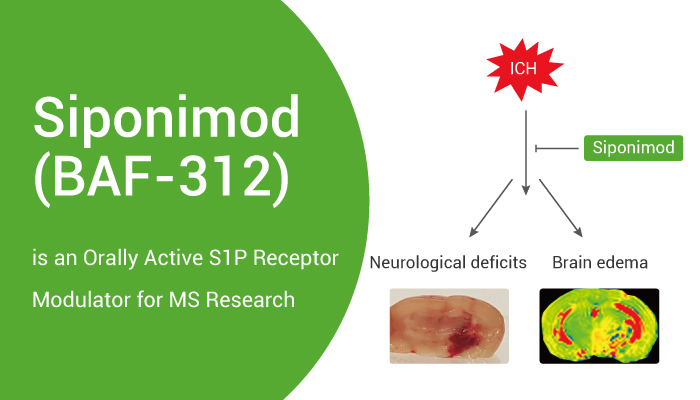Sphingosine-1-phosphate (S1P) is a signaling sphingolipid, also known as lysosphingolipid. It is a bioactive lipid mediator, found in body fluids and tissues. S1P regulates lymphocyte recirculation, cardiac function and a variety of other physiological processes. Furthermore, S1P mediates these functions primarily through its interaction with five G-protein-coupled receptors known as S1P1-5. In the vascular system, S1P regulates angiogenesis, vascular stability, and permeability. In the immune system, it a major regulator of trafficking of T- and B-cells. S1P interaction with its receptor S1PR1 is needed for the egress of immune cells from the lymphoid organs (such as thymus and lymph nodes) into the lymphatic vessels.

Siponimod (also known as BAF-312) is an orally active, next-generation and selective S1P receptor modulator.
Siponimod is more selective for S1P1 and S1P5 than S1P2, S1P3 and S1P4. In addition, Siponimod has the potential for immune-mediated diseases research, such as multiple sclerosis (MS). Siponimod has a relatively short elimination half-life that provides a rapid recovery of blood lymphocyte counts on stopping treatment. Moreover, Siponimod is extensively bound to rat, dog, monkey, and human plasma proteins (>99.9%). It shows high and passive permeability in a Caco-2 human cell permeability assay. The terminal half-life is approximately 6 and 19 h in rat and monkey, respectively. Meanwhile, redistribution of lymphocytes to secondary lymphoid organs and reduced infiltration of autoreactive cells into target tissues contribute to disease amelioration.
In a rat experimental autoimmune encephalomyelitis (EAE) model, Siponimod effectively suppresses EAE by internalizing S1P1 receptors, rendering them insensitive to the egress signal from lymph nodes. Besides, in Lewis rats, Siponimod leads to a dose-dependent reduction of peripheral lymphocyte counts that rapidly.
In summary, Siponimod is an orally active S1P receptor modulator, selective for S1P1 and S1P5 receptors. It has the potential for MS research.
References:
[1] P Gergely, et al. Br J Pharmacol. 2012 Nov;167(5):1035-47.
[2] Shifeng Pan, et al. ACS Med Chem Lett. 2013 Jan 4;4(3):333-7.